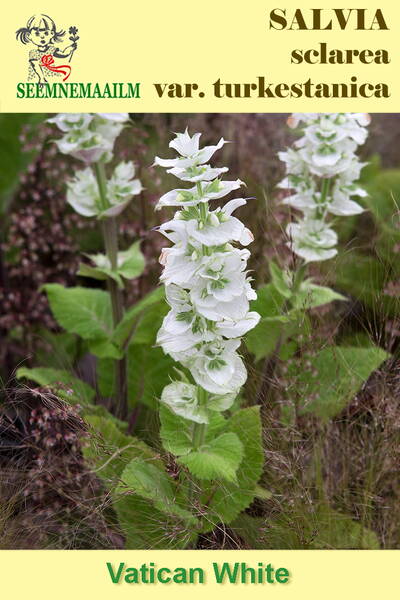Your shopping cart is empty!
Clary sage "Vatican White" (clarry, clear eye, orvale, see bright)
Salvia sclarea f. turkestanica
2.23€
Ex Tax: 1.80€
Ex Tax: 1.80€
Clarry "Vatican White" - Salvia sclarea var. turkestanica.
Attractive, very stately and large flower stalks.
Family: Lamiaceae .
It grows wild in the Black Sea region, the Caucasus, the mountains of Central Asia, the Western and Eastern Mediterranean, and Asia Minor.
A moderately fast-growing biennial plant 70-80 cm tall (grown as an annual) with large, ovate, wrinkled leaves.
In summer, fragrant, oval, pubescent leaves appear. Flowers are pink, lilac, and white, gathered in a branched, paniculate inflorescence. The bracts are large, broadly ovate, pink, or less commonly white, with a greenish edge.
Winter hardiness zones: Z4-8.
Soil requirements: dry, well-drained
Blooms in June-July. An excellent honey plant. Dies after fruiting.
1.0 g = 260 seeds.
Attractive, very stately and large flower stalks.
Family: Lamiaceae .
It grows wild in the Black Sea region, the Caucasus, the mountains of Central Asia, the Western and Eastern Mediterranean, and Asia Minor.
A moderately fast-growing biennial plant 70-80 cm tall (grown as an annual) with large, ovate, wrinkled leaves.
In summer, fragrant, oval, pubescent leaves appear. Flowers are pink, lilac, and white, gathered in a branched, paniculate inflorescence. The bracts are large, broadly ovate, pink, or less commonly white, with a greenish edge.
Winter hardiness zones: Z4-8.
Soil requirements: dry, well-drained
Blooms in June-July. An excellent honey plant. Dies after fruiting.
1.0 g = 260 seeds.
An easy-to-germinate biennial that readily self-sows. Compact and more attractive than the main species, it thrives in cool climates.
A well-known species grown for culinary and medicinal purposes, as well as for its beautiful ornamental qualities.
In the kitchen, it can be used to flavor omelets and stews. Medicinally, it is used to improve eye health and treat kidney and stomach ailments. And, interestingly, it is used to slow the aging process. It has been cultivated since 1597.












